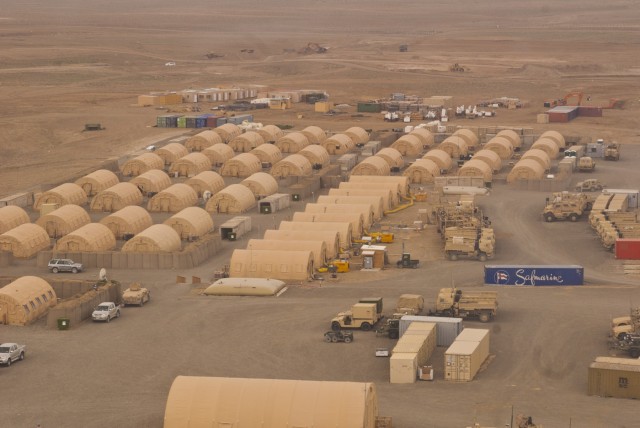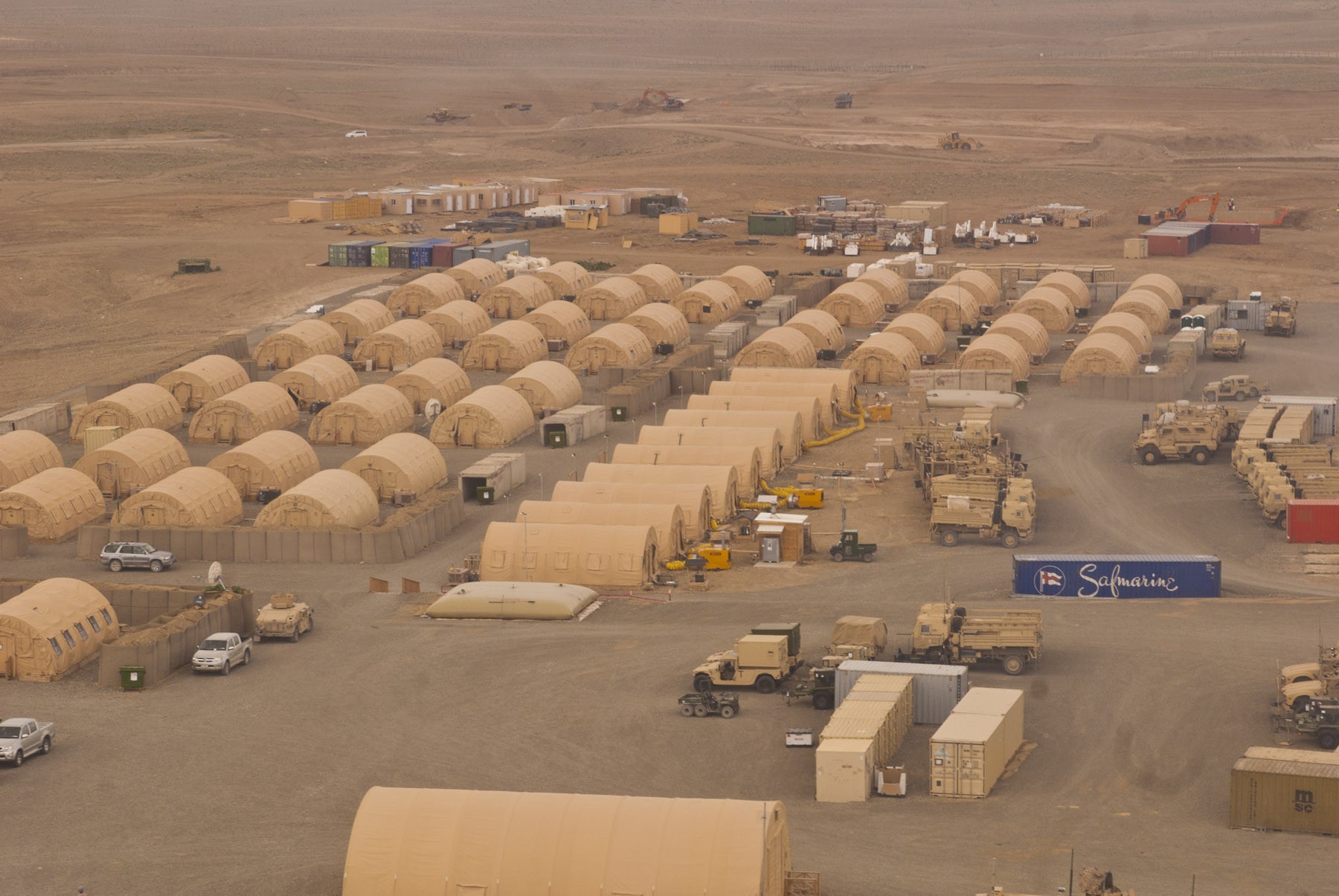FORWARD OPERATING BASE SHARANA, Afghanistan, April 29, 2011 -- The U.S. Army brigade responsible for security operations in Paktika province, Afghanistan, was faced on arrival with an enemy that felt at home, the unit's operations officer said.
Before the 4th Brigade Combat Team, 101st Airborne Division arrived here last summer as part of the troop surge, there had been few coalition forces in Paktika province, said Maj. Rob Born.
"This is the most combat power that's been in the province probably since the Soviets were here," Born said. "And as a result, I think the insurgents and the Taliban and the Haqqani network took it for granted."
Before the arrival of U.S. troops, he said, those insurgent groups could easily move large numbers of men, weapons and equipment through Paktika province.
Enemy forces had built up a command-and-control presence that established "sub-commanders" in areas throughout Paktika who acted somewhat like mafia dons or warlords, the major said.
Paktika province, Born said, is roughly the size of the state of Connecticut and shares more than 200 miles of border with Pakistan. Paktika province, he added, is a major transition zone for enemy forces transiting from Pakistan into other parts of Afghanistan, along Highway 1 from Kabul down to Kandahar.
Yet, there also are local insurgent threats, Born said.
"We talk about the threat being from Pakistan, but it's not exclusively from Pakistan," he said. "You have these sub-commanders that reside in Paktika province, and they are responsible for everything [insurgency-related] that happens in their area."
The insurgents conduct direct attacks, indirect attacks with rockets and mortars, roadside bombs, and intimidation and extortion of the locals, Born said.
"They are full-spectrum operators," he said of the insurgents. "So the threat is fighters coming in from Pakistan, as well as those sub-commanders who are responsible for moving them around."
The insurgent forces can be extremely lethal, Born said, such as last week when the brigade went after enemy combatants who demonstrated they were willing to put up a fierce fight rather than being captured.
Paktika province features mountainous terrain along the border with Pakistan, said Born, noting the province also contains several river valleys that because of deforestation are vulnerable to seasonal flooding.
Born said the terrain is a challenge, both from a command-and-control perspective and a logistics perspective. He noted the most efficient way to supply the brigade's units is by air.
"Also, the terrain physically separates the local people from governance," he said. "The road structure and the infrastructure are just not very developed. As a result, locals will take the path of least resistance -- and in many cases, in the eastern part of the province, that is toward Pakistan."
Part of the brigade's role in NATO's strategy for Afghanistan is to encourage eastern Paktika residents to look to the Kabul government for their governance, economic and life support needs, Born said.
"One of our key developmental projects is the roads," he said. "The roads are critical. You know they're critical because the enemy will fight us for the roads, particularly the key intersections near populated areas. They need the roads as much as we do."
Control of the roads gives enemy forces access to transportation, resupply, recruiting and opportunities for extortion, Born said.
"One of the things we have found after being here for nine months," he said, "is we have a shared understanding with the enemy of what's important, and that helps us target them."
Another challenge, Born said, is the Afghan population, particularly in eastern Paktika where tribal affiliations are very strong and the reach of government is weak after 30 years of civil war.
"People want stability and security," he explained. "When the tribal system provides that, you will gravitate toward it versus a government that has been somewhat effective, or ineffective, over the last 30 years."
Born's brigade is working with local Afghans to try to incorporate the positive aspects of the tribal system, such as the village shuras or councils, into local government operations.
"That's an initiative we're starting to see some success with," he said.
The brigade is strongest in its key terrain districts, Born said. One such district surrounds FOB Sharana, where the brigade is headquartered: the Sharan district, the provincial capital, a main population center, and a strong economic base with several development projects underway.
Another key area is the Orgun district, Born said, second to Sharan in population and economic development.
"You have a predominantly Tajik tribal network, and they are traditionally merchants and traders," he said. "They want a thriving economy, and they do a good job of ensuring it by working with the government and [Afghan security forces] to identify threats and share information that really helps us keep it secure."
The least secure regions in the province include the southwestern Kushamond district, which Born said is influenced by enemy forces that operate "between the seams" of two brigade combat teams' areas of responsibility.
In eastern Paktika, Born explained, the least secure areas include the Bermel district along the Pakistan border, where "lots of indirect fire, lots of rocket teams come across."
The Gayan district, also in eastern Paktika, is another area of instability, Born said, noting there is a three-way boundary where Gayan district, Pakistan and Spera district in Khost Province intersect.
"This has been an area with a significant number of lethal engagements and firefights," he said.
Instability in these areas largely comes from insurgents wishing to protect routes from Pakistan or gain access to roads in Afghanistan, he said.
Measures of the 4th Brigade's effectiveness during its current deployment in Paktika province are encouraging, Born said. His troops, he said, have eliminated many insurgent sanctuaries. And though "significant" enemy actions have occurred, he added, they've mostly been focused near the border with Pakistan.
"It's an extremely lethal fight; it's a high-risk and high-threat fight," Born said, "but when we are making contact with the enemy near the border they are having to commit a lot of resources to fighting us on the border, and those resources can't get further in."
Born said his unit has increased interdiction operations involving the delay, disruption or destruction of enemy forces and supplies located near the border.
Another key task is protecting the population, Born said, particularly in the province's key districts. Overall attacks against the Afghan population are down, he said.
Born highlighted the success of a program, which in coordination with district, provincial and central Afghan governments, trains and accredits local villagers to defend their hometowns.
"The number of Afghan local police locations [in Paktika province] right now is at four, and it's increasing," he said.
The program's success, he said, indicates that local Afghans want to protect themselves and keep the insurgents out, and that they're confident that U.S. and Afghan forces will come to their aid, if needed.
The brigade's objectives for the remaining few months of its deployment include continuing to train Afghan partner forces in route clearance techniques, effective use of artillery, and sustainment tasks such as weapons and equipment maintenance, Born said.
Another objective is to eliminate more enemy sanctuaries near the border, Born said.
"There are some focused border interdiction operations that we want to do," he said. "We also want to continue to protect the population, and retain some key terrain areas by pushing [Afghan forces] into some areas where they haven't had a persistent presence."
Meanwhile, Born said his brigade is "very close to neutralizing a key insurgent network" that operates in his area.
"I'd say there are three or four more bad guys," he said, "that if we can get [them], they are really going to have a tough time achieving their past levels of competence and capability."


Social Sharing